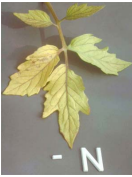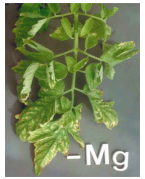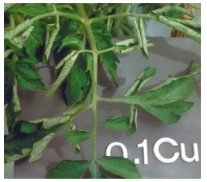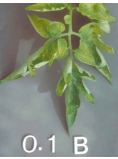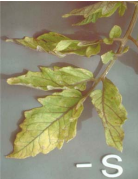Introduction
The identification of nutrient deficiency symptoms in plants is a very powerful diagnostic tool for evaluating the nutrient status of crops. However, identification of a specific single visual symptom is seldom sufficient to make a definite diagnosis of plant nutrient status. Many of the classic deficiency symptoms such as leaf tip scorch, chlorosis and necrosis are characteristically associated with more than a single mineral deficiency. In addition, other stress factors may also cause similar symptoms. Identification remains a most useful tool.
Deficiency symptoms develop as a result of a specific physiological process that cannot be completed. In general, the deficiency symptoms appear about six weeks after the deficiency develops. In crop production, the development of deficiencies must be avoided, and strategies should be in place to monitor the nutritional status of the plants, especially in the case of trees, continuously.
One such strategy is annual leaf and soil analyses. It is however possible for the concentration of certain nutrient elements to decline below the threshold for the crop. Supplemental to leaf and soil analyses, the plants in the field must be monitored for these hidden deficiencies. Observations must be reported when supplying information to the person preparing the fertilization program.
Symptoms of some Nutrient Deficiencies
Stress factors such as soil salinity, pathogens, and air pollution induce characteristic symptoms. Often, these symptoms resemble those of nutrient deficiency conditions.
Pathogens often produce interveinal chlorosis, whereas many air pollution and salinity stresses may cause tip scorching. Although at first, these symptoms might seem similar in their appearance to those of nutrient deficiencies, they do differ in detail and/or in their overall developmental pattern.
Pathological symptoms can often be separated from nutritional symptoms by their distribution in the crop. If the plants are under nutrient stress, all plants of a given type and age in the same fields tend to develop the same symptoms at the same time. If the stress is the result of a pathogen, symptom development will have a tendency to vary between plants until the pathogen is relatively advanced.
At first glance, it would appear as if the distinction between deficiency symptoms for the 13 known essential mineral nutrients should be relatively simple. But such an assumption is incorrect. The deficiency symptoms are however quite complex because each nutrient has a number of different biological functions, and each function may have an independent set of interactions. In addition, the expression of these symptoms varies depending on how acute or chronic deficiency conditions have developed. Acute deficiency occurs when a nutrient is suddenly no longer available to a rapidly growing plant. Chronic deficiency occurs when there is a limited but continuous supply of a nutrient, at a rate that is insufficient to meet the growing demands of the plant.
Most of the classic deficiency symptoms described in textbooks are characteristic of acute deficiencies. The most common symptoms of low-grade, chronic deficiencies are a tendency towards darker green leaves and stunted or slow growth. Typically, most published descriptions of deficiency symptoms arise from experiments conducted in greenhouses or growth chambers where the plants are grown in hydroponics or in media where the nutrients are fully available. In these conditions, nutrients are readily available while present, but when a nutrient is depleted, the plant suddenly faces an acute deficiency.
The interaction between nutrient mobility in the plant, and plant growth rate can be a major factor influencing the type and location of deficiency symptoms that develop. Mobile nutrients such as nitrogen and potassium, deficiency symptoms develop predominantly in the older and mature leaves. This is a result of these nutrients being preferentially mobilized during times of nutrient stress from the older leaves to the newer leaves near the growing regions of the plant. Additionally, mobile nutrients newly acquired by the roots are also preferentially translocated to new leaves and the actively growing areas. Thus, old and mature leaves become depleted of mobile nutrients during times of stress while the new leaves are maintained at a more favourable nutrient status.
The typical presence for deficiency symptoms of very few mobile nutrients such as calcium, boron, and iron initially develop in the growing regions and new leaves. In plants growing slowly for reasons other than nutrition (such as low light), lower levels of nutrients may be sufficient for the plant to slowly develop, maybe even without symptoms. This type of development is likely to occur in the case of weakly mobile nutrients because excess nutrients in the older leaves will eventually be mobilized to supply newly developing tissues. In contrast, a plant with a similar supply that is growing rapidly will develop severe deficiencies in the actively growing tissue such as leaf edges and the growing region of the plant. A classic example of this is calcium deficiency in vegetables such as lettuce. In lettuce calcium deficits symptoms develop on the leaf margins (leaf margin tip scorch) and the growing region near the meristems. The maximal growth rate of lettuce is often limited by the internal translocation rate of calcium to the growing tissue rather than from a limited nutrient supply in the.
When moderately mobile nutrients such as sulphur and magnesium are the limiting nutrients in the system, deficiency symptoms are normally seen on the entire plant. If the nutrient supply is marginal compared to the growth rate, symptoms will appear on the older tissue, but if the nutrient supply is low compared to the growth rate, or the nutrient is totally depleted, the younger tissue will become deficient first.
Prominent nutrient elements that develop hidden deficiency symptoms are nitrogen, magnesium, copper and iron.
In the following section, the deficiency symptoms expected in citrus and tomatoes are provided as examples.
Nitrogen
Citrus
Nitrogen is a mobile nutrient in plants and is translocated to areas where it is required the most. The nitrogen in older leaves is moved to new leaves shortly before leaf drop. This is a natural process, which starts when the leaves are about twenty-four months old.
Leaves under the age of twenty-four months can however be dropped prematurely when the tree experiences a nitrogen deficit. The leaves receiving the translocated nitrogen will contain elevated levels but at the cost of the older leaves. If the leaves with elevated nitrogen concentration are picked during sampling, the leaf analysis will present an incorrect reflection of the nitrogen status of the trees.
The symptoms of this process are:
- The entire tree is a slightly lighter green than normal;
- The oldest leaves turn deep yellow in colour and drop;
- Twigs have left at the tips and few or none at the middle or base;
- The tree is sparsely foliated with only one or two generations of leaves;
- Excessive leaf drop occurs a week before and during a vegetative flush.
The nitrogen concentration in the leaves decreases but stabilises at a level in the “below normal” range, not indicating that this status is sustained by relocated nitrogen from leaves dropped prematurely. The leaves on the tree have a reasonable nitrogen status but this “fairly good” status is applicable to much fewer leaves.
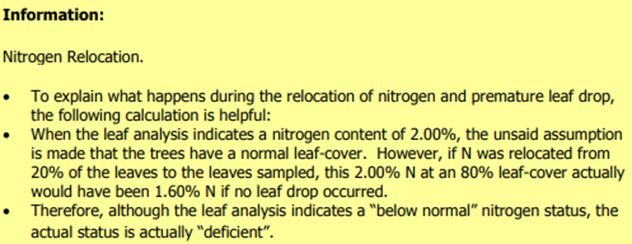
Additional information is required to interpret the analytical data if the trees are growing under abnormal conditions or showing abnormal symptoms such as sparse foliation.
Tomato
Figure 3.1 provided a photograph of chlorosis (yellowing) developing due to nitrogen deficiency. A light red discolouration can also be seen on the veins and petioles. Under nitrogen deficiency, the older mature leaves gradually change from their normal characteristic green appearance to a much paler green. As the deficiency progresses these older leaves become uniformly yellow (chlorotic). Leaves approach a yellowish-white colour under extreme deficiency. The young leaves at the top of the plant maintain a green, but paler colour, and tend to become smaller in size. Branching is reduced in nitrogen-deficient plants resulting in short, spindly plants. The yellowing in nitrogen deficiency is uniform over the entire leaf including the veins. However, in some instances, interveinal necrosis (between veins) replaces the chlorosis commonly found in many plants. In some plants, the underside of the leaves and/or the petioles and midribs develop traces of a reddish or purple colour. In some plants, this colouration can be quite bright. As the deficiency progresses, the older leaves also show more of a tendency to wilt under mild water stress and become senescent much earlier than usual. Recovery of deficient plants to applied nitrogen is immediate (days) and spectacular.
Figure 3.1. Nitrogen deficiency symptoms in tomatoes. (Epstein and Bloom 2004)
Magnesium
Citrus
Magnesium is a mobile nutrient and the same process as with nitrogen occurs when the supply of magnesium is too low. Magnesium deficiency symptoms are more prominent on seeded cultivars.
The symptoms are:
- No change in the green appearance of the entire tree;
- The oldest leaves develop yellowing from the margins and tip towards the petiole, leaving a unique inverted V-shaped green area with its broadest side at the petiole;
- Twigs have leaves at the tips and few or none at the middle or base;
- The tree is sparsely foliated with only one or two generations of leaves;
- Excessive leaf-drop occurs during the onset of spring and/or during a vegetative flush;
- Excessive leaf drop can also occur after a foliar application of potassium. Applications of potassium will aggravate the hidden magnesium deficiency.
The magnesium concentration in the leaf decreases but stabilises at a level in the “below normal” range, not indicating that this status is sustained by relocated magnesium from leaves dropped prematurely.
Tomato
Figure 3.2 provided a photograph of Mg-deficits in tomato leaves indicating advanced interveinal chlorosis, with necrosis (browning dying leaf tissue) developing in the highly chlorotic tissue. In its advanced form, magnesium deficiency may superficially resemble potassium deficiency. In the case of magnesium deficiency, the symptoms generally start with mottled chlorotic areas developing in the interveinal tissue. The interveinal leaf tissue tends to expand proportionately more than the other leaf tissues, producing a raised puckered surface, with the top of the puckers progressively going from chlorotic to necrotic tissue. In some plants such as the Brassica or mustard family, which includes vegetables such as broccoli, Brussels sprouts, cabbage, cauliflower, collards, kale, kohlrabi, mustard, rape, rutabaga and turnip, tints of orange, yellow, and purple may also develop.
Figure 3.2. Symptoms of Magnesium deficiency on a tomato plant. (Epstein and Bloom 2004)
Copper
Citrus
Copper moves slowly through plants. When a strong vegetative flush develops, the supply of copper to the leaves formed on new shoots might be too low and copper deficiency symptoms develop. The symptom will be more pronounced on the lower leaves on a shoot and becomes less obvious towards the tip of the shoot.
The typical leaf symptom of copper deficiency is abnormally large leaves. The leaves at the base of a shoot are two to four times the normal size and are sometimes the shape of a boat.
When copper deficiency symptoms appear on leaves of a twig exceeding 50 cm in length, it can be attributed to a natural slow supply of copper. However, if symptoms appear on shorter twigs, the copper supply must be supplemented.
Gumming is often connected to a copper deficiency, but gumming is a natural response of the tree to many adverse conditions and not only a copper deficiency.
Tomato
Figure 3.3. provides a photograph of typical copper-deficiency symptoms in tomato leaves. The leaves are curled, and petioles bent downward. Copper deficiency may be expressed as light overall chlorosis along with a permanent loss of turgor (wilting) in young leaves. Recently matured leaves show netted, green veining with areas bleaching to a whitish-grey. Some leaves develop sunken necrotic spots and have a tendency to bend downward. Trees under chronic copper deficiency develop a rosette form of growth. Leaves are small and chlorotic with spotty necrosis.
Figure 3.3. Copper deficiency symptoms in tomatoes. (Epstein and Bloom 2004)
Iron
Citrus
Iron is present in leaves as both physiologically active and inactive forms. Traditionally leaf analyses do not distinguish between these forms and will only indicate the total iron content.
The availability of iron depends on external factors such as soil pH and the concentration of bicarbonates in the soil, the water and the plant. When the soil pH is high, less iron is available to be taken up by the plant. Once taken up, the iron can be inactivated by bicarbonates. Bicarbonates are present in the irrigation water, but also in the cell-sap in the plant. Inactive iron accumulates in the leaves and forms part of the iron concentration detected during analysis. A plant can therefore suffer an iron deficiency although the leaf analysis indicates normal, high or excess concentrations of iron. Leaf analyses are only useful when the results indicate a low to deficient iron concentration.
Iron is not relocated in the plant and deficiency symptoms develop on the newly formed leaves. The symptoms are more prominent during winter and at the lower shaded part of the canopy.
Tomato
Figure 3.4 provides a photograph of iron-deficient leaves showing severe chlorosis at the base of the leaves with some green netting. The most common symptom of iron deficiency starts out as interveinal chlorosis of the youngest leaves, which develops into overall chlorosis. These areas often develop into necrotic spots. Up until the time where leaves become almost completely white, they will recover if supplemental iron is provided. In the recovery phase, the veins are the first to recover as indicated by their bright green colour. This distinct venial re-greening observed during iron deficit recovery is probably the most recognizable symptom in all of the classical plant nutrition. Because iron has low mobility, iron deficiency symptoms appear first on the youngest leaves. Iron deficiency is strongly associated with calcareous soils and anaerobic conditions, and it is often induced by an excess of heavy metals.
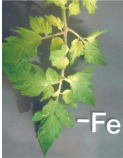
Figure 3.4. Iron deficiency symptoms in tomatoes. (Epstein and Bloom 2004)
Common Deficiency Symptoms on Tomatoes and other Vegetable Crops
Phosphorus
Figure 3.5 provides a photograph of phosphorus-deficient leaves, showing necrotic spots. As a rule, phosphorus deficiency symptoms are not very distinct and thus difficult to identify. A major visual symptom is that the plants are dwarfed or stunted. Phosphorus deficient plants develop very slowly in relation to other plants growing under similar environmental conditions but without phosphorus deficiency. Phosphorus deficient plants are often mistaken for unstressed but much younger plants. Some species such as tomato, lettuce, corn and brassicas develop a distinct purpling of the stem, petiole and the undersides of the leaves. Under severe deficiency conditions, there is also a tendency for leaves to develop a blue-grey lustre (shine). In older leaves under very severe deficiency conditions, a brown netted veining of the leaves may develop.
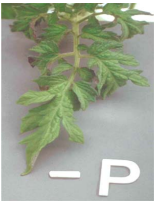
Figure 3.5. Phosphorus deficiency symptoms in tomatoes. (Epstein and Bloom 2004)
Potassium
Figure 3.6 provides a photograph of potassium deficiency in tomato plants showing marginal necrosis (tip scorch). Advanced potassium deficiency is seen as chlorosis of the interveinal spaces between the main veins as well as with interveinal necrosis. This group of symptoms is very characteristic of K deficiency.
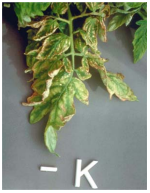
Figure 3.6. Potassium deficiency symptoms in tomatoes. (Epstein and Bloom 2004)
Calcium
Figure 3.7 provides a photograph of calcium-deficient leaves showing necrosis at the base of the leaves. The low mobility of calcium is a major factor in determining the expression of calcium deficiency symptoms. Classic symptoms of calcium deficiency include blossom-end rot in tomato (browning or rotting of the blossom end of tomato fruit), leaf tip scorch in lettuce, blackheart in celery and death of the growing regions in many plants. All these symptoms show soft dead necrotic tissue at rapidly growing areas, which is generally related to poor translocation of calcium to the tissue rather than a low external supply of calcium. Very slow-growing plants with a deficient supply of calcium may withdraw sufficient calcium from older leaves to maintain growth with only marginal chlorosis of the leaves. This ultimately results in the margins of the leaves growing more slowly than the rest of the leaf, causing the leaf to cup downward. This symptom often progresses to the point where the petioles develop but the leaves do not, leaving only a dark bit of necrotic tissue at the top of each petiole. Plants under chronic calcium deficiency have a much greater tendency to wilt than non-stressed plants.
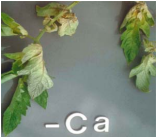
Figure 3.7. Calcium deficiency symptoms in tomatoes. (Epstein and Bloom 2004)
Boron
Figure 3.8 provides a photograph of boron-deficient leaves showing light general chlorosis. The tolerance of plants to boron varies greatly between species. Boron requirements necessary for one crop may be toxic to other boron sensitive crops. Boron is poorly transported in the phloem of most plants. In plants with poor boron mobility, boron deficiency results in necrosis of meristematic tissues in the growing regions, leading to loss of apical dominance and the development of a rosette condition. These deficiency symptoms are similar to those caused by calcium deficiency. In plants in which boron is readily transported in the phloem, the deficiency symptoms localize in the mature tissues, similar to those of nitrogen and potassium. Both the pith and the epidermis of stems may be affected, often resulting in hollow or roughened stems along with necrotic spots on the fruit. The leaf blades develop a pronounced crinkling and there is a darkening and crackling of the petioles often with exudation of syrupy material from the leaf blade. The leaves are unusually brittle and tend to break easily. Also, there is often a wilting of the younger leaves even under an adequate water supply, pointing to a disruption of water transport caused by a boron deficiency.
Boron also plays an important role in the reproduction of plants. Boron deficiency sunflower will show poor seed set and in severe cases of B deficiency, it may lead to misshapen sunflower heads and even snapping of the stem directly below the sunflower head. It is therefore very important to monitor the B status of the soil and plants when sunflower is cultivated, as B deficiencies can cause severe yield losses.
Figure 3.8. Boron deficiency symptoms in tomatoes. (Epstein and Bloom 2004)
Sulphur
Figure 3.9 provides a photograph of sulphur deficient leaves, showing general overall chlorosis while still retaining some green colour. The veins and petioles show a distinct reddish colour. The visual symptoms of sulphur deficiency are very similar to the chlorosis found due to nitrogen deficiency. However, in sulphur deficiency, the yellowing is much more uniform over the entire plant including young leaves. The reddish colour is often found on the underside of the leaves and the petioles have a more pinkish tone and is much less vivid than that found in nitrogen deficiency. With an advanced sulphur deficiency, brown lesions and/or necrotic spots often develop along the petiole, and the leaves tend to become more erect and often twisted and brittle.
Figure 3.9. Sulphur deficiency symptoms in tomatoes. (Epstein and Bloom 2004)
Zinc
Figure 3.10. provides a photograph of a zinc-deficient leaf showing an advanced state of interveinal necrosis. In the early stages of zinc deficiency, the younger leaves become yellow and pitting develops in the interveinal upper surfaces of the mature leaves. As the deficiency progress, these symptoms develop into intense interveinal necrosis but the main veins remain green, as in the symptoms of recovering iron deficiency. In many plants, especially trees, the leaves become very small and the internodes shorten, producing a rosette-like appearance.

Figure 3.10. Zinc deficiency symptoms in tomatoes. (Epstein and Bloom 2004)
